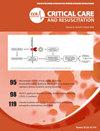Long-term outcomes of patients who received extracorporeal cardiopulmonary resuscitation (ECPR) following in-hospital cardiac arrest: Analysis of EXCEL registry data
IF 1.4
4区 医学
Q3 CRITICAL CARE MEDICINE
引用次数: 0
Abstract
Objective
To describe the six-month functional outcomes of patients who received extracorporeal cardiopulmonary resuscitation (ECPR) following in-hospital cardiac arrest (IHCA) in Australia.
Design
Secondary analysis of EXCEL registry data.
Setting
EXCEL is a high-quality, prospective, binational registry including adult patients who receive extracorporeal membrane oxygenation (ECMO) in Australia and New Zealand.
Participants
Patients reported to the EXCEL registry who received ECPR following IHCA and had the six-month outcome data available were included.
Main outcome measures
The primary outcome was functional outcome at six months measured using the modified Rankin scale (mRS). The secondary outcomes included mortality, disability, health status, and complications.
Results
Between 15th February 2019 and 31st August 2022, 113/1251 (9.0%) patients in the registry received ECPR following IHCA (mean age 50.7 ± 13.7 years; 79/113 (69.9%) male; 74/113 (65.5%) non-shockable rhythm). At 6 months, 37/113 (32.7%) patients were alive, most (27/34 [79.4%]) with a good functional outcome (mRS 0–3). Patients had increased disability [WHODAS % Score 25.58 ± 23.39% vs 6.45 ± 12.32%; mean difference (MD) [95% (confidence interval) CI] −19.13 (−28.49 to −9.77); p < 0.001] and worse health status [EuroQol five-dimension, five-level (EQ-5D-5L) index value 0.73 ± 0.23 vs. 0.89 ± 0.14; MD (95% CI) 0.17 (0.07 to 0.26); p = 0.003] at six months compared with the baseline. The patients reported a median of 4.5 (2–6) complications at six-month follow-up.
Conclusion
One in three patients who received ECPR following IHCA were alive at six months and most had a good functional outcome. However, survivors reported higher levels of disability and a worse health status at six months compared with the baseline and ongoing complications were common.
院内心脏骤停后接受体外心肺复苏(ECPR)患者的长期结局:EXCEL注册数据分析
目的:描述澳大利亚住院心脏骤停(IHCA)后接受体外心肺复苏(ECPR)患者的六个月功能结局。设计:对EXCEL注册表数据进行二次分析背景:EXCEL是一项高质量、前瞻性的两国登记,包括澳大利亚和新西兰接受体外膜氧合(ECMO)的成年患者。参与者:纳入了在IHCA后接受ECPR并有6个月结果数据的EXCEL登记处报告的患者。主要转归指标:主要转归指标为6个月时的功能转归,采用改良Rankin量表(mRS)测量。次要结局包括死亡率、残疾、健康状况和并发症。结果:在2019年2月15日至2022年8月31日期间,登记的113/1251例(9.0%)患者在IHCA后接受了ECPR(平均年龄50.7±13.7岁;男性79/113 (69.9%);74/113(65.5%)非震荡节律)。6个月时,37/113(32.7%)患者存活,大多数(27/34(79.4%))功能预后良好(mRS 0-3)。患者残疾程度增加[WHODAS %评分25.58±23.39% vs 6.45±12.32%;平均差(MD)[95%可信区间]-19.13 (-28.49 ~ -9.77);P = 0.003] 6个月时与基线比较。在6个月的随访中,患者报告了中位4.5(2-6)例并发症。结论:在IHCA后接受ECPR的患者中,有三分之一的患者在6个月时存活,并且大多数具有良好的功能预后。然而,与基线相比,幸存者在6个月时报告的残疾程度更高,健康状况更差,持续的并发症很常见。
本文章由计算机程序翻译,如有差异,请以英文原文为准。
求助全文
约1分钟内获得全文
求助全文
来源期刊

Critical Care and Resuscitation
CRITICAL CARE MEDICINE-
CiteScore
7.70
自引率
3.40%
发文量
44
审稿时长
>12 weeks
期刊介绍:
ritical Care and Resuscitation (CC&R) is the official scientific journal of the College of Intensive Care Medicine (CICM). The Journal is a quarterly publication (ISSN 1441-2772) with original articles of scientific and clinical interest in the specialities of Critical Care, Intensive Care, Anaesthesia, Emergency Medicine and related disciplines.
The Journal is received by all Fellows and trainees, along with an increasing number of subscribers from around the world.
The CC&R Journal currently has an impact factor of 3.3, placing it in 8th position in world critical care journals and in first position in the world outside the USA and Europe.
 求助内容:
求助内容: 应助结果提醒方式:
应助结果提醒方式:


